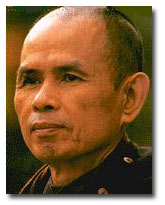


Venerable Thich Nhat Hanh
Organisation: The Community of Mindful Living
Lineage: The Community of Mindful Living (CML) is guided by the Fourteen Mindfulness Trainings for Engaged Buddhism of the Order of Interbeing–the Tiep Hien Order. Tiep means “being in touch with” and “continuing.” Hien means “realizing” and “making it here and now.” The Order of Interbeing was formed by Thich Nhat Hanh in the mid-1960s, at a time when the Vietnam War was escalating and the teachings of the Buddha were desperately needed to combat the hatred, violence, and divisiveness enveloping his country. From its inception and in the present, the Order was comprised of all four membership categories of the original Buddhist community–monks, nuns, laymen, and laywomen.
Source: Web site: www.iamhome.org
Biography: Thich Nhat Hanh is a Vietnamese Buddhist monk. During the war in Vietnam, he worked tirelessly for reconciliation between North and South Vietnam. His lifelong efforts to generate peace moved Martin Luther King, Jr. to nominate him for the Nobel Peace Prize in 1967. He lives in exile in a small community in France where he teaches, writes, gardens, and works to help refugees worldwide. He has conducted many mindfulness retreats in Europe and North America helping veterans, children, environmentalists, psychotherapists, artists and many thousands of individuals seeking peace in their hearts, and in their world.
“Every day we do things, we are things that have to do with peace. If we are aware of our life…, our way of looking at things, we will know how to make peace right in the moment, we are alive.”
Thich Nhat Hanh has been living in exile from his native Vietnam since the age of forty. In that year of 1966, he was banned by both the non-Communist and Communist governments for his role in undermining the violence he saw affecting his people. A Buddhist monk since the age of sixteen, Thay (“teacher,” as he is commonly known to followers) earned a reputation as a respected writer, scholar, and leader. He championed a movement known as “Engaged Buddhism,” which intertwined traditional meditative practices with active nonviolent civil disobedience. This movement lay behind the establishment of the most influential center of Buddhist studies in Saigon, the An Quang Pagoda. He also set up relief organizations to rebuild destroyed villages, instituted the School of Youth for Social Service (a Peace Corps of sorts for Buddhist peace workers), founded a peace magazine, and urged world leaders to use nonviolence as a tool. Although his struggle for cooperation meant he had to relinquish a homeland, it won him accolades around the world.
When Thich Nhat Hanh left Vietnam, he embarked on a mission to spread Buddhist thought around the globe. In 1966, when Thây came to the United States for the first of many humanitarian visits, the territory was not completely new to him: he had experienced American culture before as a student at Princeton, and more recently as a professor at Columbia. The Fellowship of Reconciliation and Cornell invited Thay to speak on behalf of Buddhist monks, and he offered an enlightened view on ways to end the Vietnam conflict. He spoke on college campuses, met with administration officials, and impressed social dignitaries. The following year, Nobel Peace Prize winner Dr. Martin Luther King, Jr., nominated Thich Nhat Hanh for the same honor. Hanh’s Buddhist delegation to the Paris peace talks resulted in accords between North Vietnam and the United States, but his pacifist efforts did not end with the war. He also helped organize rescue missions well into the 1970’s for Vietnamese trying to escape from political oppression. Even after the political stabilization of Vietnam, Thich Nhat Hanh has not been allowed to return home. The government still sees him as a threat-ironic, when one considers the subjects of his teachings: respect for life, generosity, responsible sexual behavior, loving communication, and cultivation of a healthful life style.
Thay now lives in southwestern France, where he founded a retreat center twelve years ago. At the center, Plum Village, he continues to teach, write, and garden. Plum Village houses only thirty monks, nuns, and laypeople, but thousands from around the globe call it home. Accommodation is readily available for short-term visitors seeking spiritual relief, for refugees in transit, or for activists in need of inspiration. Thich Nhat Hanh gathers people of diverse nationalities, races, religions, and sexes in order to expose them to mindfulness-taking care in the present moment, being profoundly aware and appreciative of life.
Despite the fact that Thay is nearing seventy, his strength as a world leader and spiritual guide grows. He has written more than seventy-five books of prose, poetry, and prayers. Most of his works have been geared toward the Buddhist reader, yet his teachings appeal to a wide audience. For at least a decade, Thich Nhat Hanh has visited the United States every other year; he draws more and more people with each tour, Christian, Jewish, atheist, and Zen Buddhist alike. His philosophy is not limited to preexistent religious structures, but speaks to the individual’s desire for wholeness and inner calm. In 1993, he drew a crowd of some 1,200 people at the National Cathedral in Washington DC, led a retreat of 500 people in upstate New York, and assembled 300 people in West Virginia. His popularity in the United States inspired the mayor of Berkeley, California, to name a day in his honor and the Mayor of New York City declared a Day of Reconciliation during his 1993 visit. Clearly, Thich Nhat Hanh is a human link with a prophetic past, a soft-spoken advocate of peace, Buddhist community, and the average American citizen.
Main Centre:
Plum Village:
Vietnamese Zen master Thich Nhat Hanh’s meditation community in the south of France is an abode of harmony, peace, and ethnic diversity. As I drive past the vineyards, chateaux, and sunflower fields of southwestern France, en route to Plum Village, I find myself wondering why I’m going there for my vacation. Wouldn’t I really rather be exploring the nearby medieval town of St. Emilion, famous for its macaroons? Or sampling Bordeaux wines? Or slathering Camembert onto French bread while lounging on the beach? But after five minutes in Plum Village, all doubts vanish. This is clearly not a monastery-children race about laughing and calling to each other in Vietnamese, French, and English; gray-haired women chatter in Vietnamese as they prepare rice and vegetables in the communal kitchen; a group of teenagers sit under a tree playing sitars. But permeating all of this activity is a sense of peace and simplicity that I find deeply refreshing after a week of frenzied tourism.
This interweaving of practice and daily living is the essence of Plum Village, founded in the early 1980’s to fulfill Nhat Hanh’s decades-old dream of a community where people involved in the work of social transformation could come for rest and spiritual nourishment. Exiled from his native Vietnam because of his antiwar activities, he finally established his spiritual oasis on eighty acres of land in the wine country east of Bordeaux. In exchange for a home, Vietnamese refugees helped clean and renovate the beautiful, rustic, eighteenth-century stone farm buildings and construct additional cinder block structures. Currently, only about fifty residents stay year-round, studying Buddhism, working to help Vietnamese refugees and political prisoners, and tending the 1,250 plum trees, whose crop earns money to send medicine to Vietnam. But for one month each summer, the community is open to the public, and nearly 1,000 visitors – about half Vietnamese and half Westerners – come to practice. This month is by no means a grueling meditation retreat. In fact, Nhat Hanh likes to use the word “treat,” rather than “retreat,” to describe these gatherings of Buddhist practitioners. The emphasis is on learning skills for bringing mindfulness into everyday life. Family practice is central, and children are wholeheartedly encouraged to participate in all activities, including meditation, tea ceremonies, and Dharma talks. Typically, Tha^y directs the first ten minutes of every talk to the children, who then play outside for the rest of the talk.
No matter what the activity, visitors are gently reminded to perform it with joy and awareness. For me, the spirit of Plum Village is epitomized by the carved wooden sign beside the walking meditation path: “The mind can go in a thousand directions, but on this beautiful path, I walk in peace. With each step, the wind blows. With each step, a flower blooms.”
– From A Joyful Path , “Plum Village Summer Opening” by Anne Cushman.
At PLUM VILLAGE leads a year-round program of meditation practice for residents and for visitors who come for at least one week. The Summer Opening is from July 15 to August 15. For information write in advance to:
Registrar
Plum Village
Meyrac
47120 Loubès-Bernac
France
- Main Web site: www.plumvillage.org

